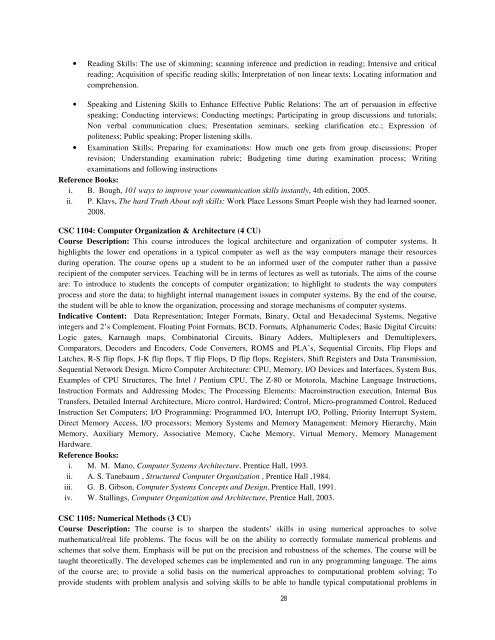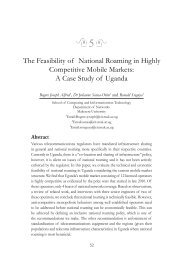Undergraduate Handbook - School of Computing and Informatics ...
Undergraduate Handbook - School of Computing and Informatics ...
Undergraduate Handbook - School of Computing and Informatics ...
Create successful ePaper yourself
Turn your PDF publications into a flip-book with our unique Google optimized e-Paper software.
• Reading Skills: The use <strong>of</strong> skimming; scanning inference <strong>and</strong> prediction in reading; Intensive <strong>and</strong> critical<br />
reading; Acquisition <strong>of</strong> specific reading skills; Interpretation <strong>of</strong> non linear texts; Locating information <strong>and</strong><br />
comprehension.<br />
• Speaking <strong>and</strong> Listening Skills to Enhance Effective Public Relations: The art <strong>of</strong> persuasion in effective<br />
speaking; Conducting interviews; Conducting meetings; Participating in group discussions <strong>and</strong> tutorials;<br />
Non verbal communication clues; Presentation seminars, seeking clarification etc.; Expression <strong>of</strong><br />
politeness; Public speaking; Proper listening skills.<br />
• Examination Skills; Preparing for examinations: How much one gets from group discussions; Proper<br />
revision; Underst<strong>and</strong>ing examination rubric; Budgeting time during examination process; Writing<br />
examinations <strong>and</strong> following instructions<br />
Reference Books:<br />
i. B. Bough, 101 ways to improve your communication skills instantly, 4th edition, 2005.<br />
ii. P. Klavs, The hard Truth About s<strong>of</strong>t skills: Work Place Lessons Smart People wish they had learned sooner,<br />
2008.<br />
CSC 1104: Computer Organization & Architecture (4 CU)<br />
Course Description: This course introduces the logical architecture <strong>and</strong> organization <strong>of</strong> computer systems. It<br />
highlights the lower end operations in a typical computer as well as the way computers manage their resources<br />
during operation. The course opens up a student to be an informed user <strong>of</strong> the computer rather than a passive<br />
recipient <strong>of</strong> the computer services. Teaching will be in terms <strong>of</strong> lectures as well as tutorials. The aims <strong>of</strong> the course<br />
are: To introduce to students the concepts <strong>of</strong> computer organization; to highlight to students the way computers<br />
process <strong>and</strong> store the data; to highlight internal management issues in computer systems. By the end <strong>of</strong> the course,<br />
the student will be able to know the organization, processing <strong>and</strong> storage mechanisms <strong>of</strong> computer systems.<br />
Indicative Content: Data Representation; Integer Formats, Binary, Octal <strong>and</strong> Hexadecimal Systems, Negative<br />
integers <strong>and</strong> 2’s Complement, Floating Point Formats, BCD, Formats, Alphanumeric Codes; Basic Digital Circuits:<br />
Logic gates, Karnaugh maps, Combinatorial Circuits, Binary Adders, Multiplexers <strong>and</strong> Demultiplexers,<br />
Comparators, Decoders <strong>and</strong> Encoders, Code Converters, ROMS <strong>and</strong> PLA’s, Sequential Circuits, Flip Flops <strong>and</strong><br />
Latches, R-S flip flops, J-K flip flops, T flip Flops, D flip flops, Registers, Shift Registers <strong>and</strong> Data Transmission,<br />
Sequential Network Design. Micro Computer Architecture: CPU, Memory, I/O Devices <strong>and</strong> Interfaces, System Bus,<br />
Examples <strong>of</strong> CPU Structures, The Intel / Pentium CPU, The Z-80 or Motorola, Machine Language Instructions,<br />
Instruction Formats <strong>and</strong> Addressing Modes; The Processing Elements: Macroinstruction execution, Internal Bus<br />
Transfers, Detailed Internal Architecture, Micro control, Hardwired; Control, Micro-programmed Control, Reduced<br />
Instruction Set Computers; I/O Programming: Programmed I/O, Interrupt I/O, Polling, Priority Interrupt System,<br />
Direct Memory Access, I/O processors; Memory Systems <strong>and</strong> Memory Management: Memory Hierarchy, Main<br />
Memory, Auxiliary Memory, Associative Memory, Cache Memory, Virtual Memory, Memory Management<br />
Hardware.<br />
Reference Books:<br />
i. M. M. Mano, Computer Systems Architecture, Prentice Hall, 1993.<br />
ii. A. S. Tanebaum , Structured Computer Organization , Prentice Hall ,1984.<br />
iii. G. B. Gibson, Computer Systems Concepts <strong>and</strong> Design, Prentice Hall, 1991.<br />
iv. W. Stallings, Computer Organization <strong>and</strong> Architecture, Prentice Hall, 2003.<br />
CSC 1105: Numerical Methods (3 CU)<br />
Course Description: The course is to sharpen the students’ skills in using numerical approaches to solve<br />
mathematical/real life problems. The focus will be on the ability to correctly formulate numerical problems <strong>and</strong><br />
schemes that solve them. Emphasis will be put on the precision <strong>and</strong> robustness <strong>of</strong> the schemes. The course will be<br />
taught theoretically. The developed schemes can be implemented <strong>and</strong> run in any programming language. The aims<br />
<strong>of</strong> the course are; to provide a solid basis on the numerical approaches to computational problem solving; To<br />
provide students with problem analysis <strong>and</strong> solving skills to be able to h<strong>and</strong>le typical computational problems in<br />
28

















